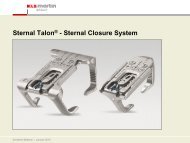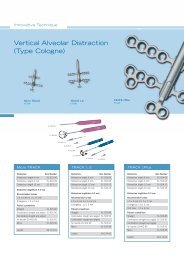Hand Surgery HBS
Hand Surgery HBS
Hand Surgery HBS
Sie wollen auch ein ePaper? Erhöhen Sie die Reichweite Ihrer Titel.
YUMPU macht aus Druck-PDFs automatisch weboptimierte ePaper, die Google liebt.
26-350-09<br />
26-350-11<br />
26-350-17<br />
3,9 mm<br />
2,0 mm<br />
3,0 mm<br />
Abb. 5: Die Reduzierhülse wird nun aus dem<br />
Einsatz herausgezogen und der kanülierte<br />
Bohrer (26-350-09) über den Führungsdraht<br />
geschoben, nachdem zuvor die mit der Messhülse<br />
ermittelte Bohrtiefe korrekt eingestellt,<br />
d. h. mit der unteren Rändelschraube fixiert<br />
wurde. Der Bohrer wird nun entlang des Führungsdrahts<br />
vorsichtig und unter Bildwandlerkontrolle<br />
so weit eingebracht, bis die Rändelschraube<br />
auf der Bohrhülse aufsetzt.<br />
HINWEIS:<br />
Es empfiehlt sich, den Bohrer während des<br />
Bohrvorgangs je nach Bedarf ein- oder mehrmals<br />
herauszuziehen und zu säubern, damit<br />
der Führungsdraht nicht durch das Bohrmehl<br />
im Bohrer verklemmt wird. Andernfalls nämlich<br />
wird der Führungsdraht beim Entnehmen<br />
des Bohrers mit herausgezogen und muss<br />
anschließend erneut korrekt platziert werden<br />
(ggf. unter Zuhilfenahme der Reduzierhülse),<br />
bevor mit Schritt 6 fortgefahren werden kann.<br />
Zur Einbringung des Führungsdrahtes und des<br />
kanülierten Bohrers verwendet man am besten<br />
eine kleine Bohrmaschine mit niedriger Drehgeschwindigkeit.<br />
Alternativ kann der kanülierte<br />
Bohrer mit Hilfe des im Set verfügbaren Bohrhandgriffs<br />
(26-350-11) natürlich auch manuell<br />
eingebracht werden.<br />
Abb. 6: Mit dem Schraubendreher<br />
(26-350-17) wird nun eine Schraube<br />
passender Länge (26-300-xx oder<br />
26-310-xx ) aus dem Rack entnommen<br />
und über den Führungsdraht implantiert,<br />
bis beim Eindringen des größeren Gewindes<br />
in den Knochen zunehmend Widerstand<br />
spürbar wird.<br />
HINWEIS:<br />
Sollte für eine optimale Fixation erhöhte<br />
Kompression erforderlich sein (z. B. im<br />
Falle einer Pseudarthrose), kann statt<br />
der Standard-Kompressionsschraube<br />
(26-300-xx) die hohe Kompressionsschraube<br />
(26-310-xx) verwendet werden.<br />
Wegen der interfragmentären Kompression<br />
empfehlen wir, eine Schraubenlänge zu<br />
wählen, die 2 mm kürzer ist als die<br />
eingestellte Bohrtiefe.<br />
Abb. 7: Der Führungsdraht sollte nun entfernt<br />
und anschließend die Schraube mit<br />
dem Schraubendreher komplett eingebracht<br />
werden. Dabei sollte darauf geachtet werden,<br />
dass, sobald der Schraubendreher an<br />
der Bohrhülse anschlägt, nicht mehr weitergedreht<br />
wird.<br />
ACHTUNG:<br />
Der Führungsdraht sollte stets entnommen<br />
werden, bevor die Schraube fest angezogen<br />
wird. Andernfalls kann es passieren, dass<br />
die Drahtspitze umgebogen wird und der<br />
Führungsdraht sich anschließend nicht<br />
mehr herausziehen lässt.<br />
Abb. 8: Der <strong>Hand</strong>griff mit Bohrhülse wird<br />
nun entfernt und die Schraube noch ein bis<br />
zwei Umdrehungen eingedreht, damit das<br />
größere Gewinde bis leicht unterhalb der<br />
Knochenoberfläche versenkt ist.<br />
Sollte es beim Neuansetzen des Schraubendrehers<br />
Probleme geben, kann der<br />
Führungsdraht noch einmal lose positioniert<br />
werden, um die Schraubendreherspitze<br />
gut in der Schraube zu zentrieren.<br />
Fig. 5: The reduction sleeve is now removed<br />
from the drill guide and the cannulated drill<br />
(26-350-09) is passed over the guide wire,<br />
the drill stop having been set at the depth<br />
indicated by the measuring sleeve.<br />
The drill is carefully advanced along the<br />
guide wire under x-ray control, until the<br />
drill stop reaches the end of the drill guide,<br />
indicating that the drill has reached its<br />
full depth.<br />
ATTENTION:<br />
It is recommended that the drill is withdrawn<br />
and cleaned one or more times during<br />
insertion, to prevent it from ‘binding’ to the<br />
guide wire; should this occur, the guide wire<br />
is likely to be withdrawn with the drill, in<br />
which case it should be repositioned (using<br />
the reduction sleeve if necessary) before<br />
moving to the next stage (Step 6).<br />
Insertion of the guide wire and of the<br />
cannulated drill is best done using a suitable,<br />
slow-speed, small power instrument.<br />
If not available, then insertion of the cannulated<br />
drill may be done by hand, using<br />
the drill handle (26-350-11) contained<br />
in the set.<br />
Fig. 6: The screwdriver (26-350-17) is used<br />
to lift a screw (26-300-xx or 26-310-xx ) of<br />
correct length from the rack in the tray.<br />
The screw is passed over the guide wire and<br />
is inserted until increased resistance is felt<br />
as the trailing thread enters the bone<br />
.<br />
ATTENTION:<br />
Should increased compression be required<br />
in order to produce optimum fixation (for<br />
example in the case of a nonunion) then<br />
the high compression screw (26-310-xx)<br />
may be selected in preference to the<br />
standard screw (26-300-xx).<br />
Due to interfragmentary compression we<br />
recommend to select a screw length which is<br />
2 mm shorter than the adjusted drill depth.<br />
Fig. 7: At this stage the guide wire should<br />
be removed, the screwdriver re-inserted and<br />
the screw advanced until the screwdriver<br />
abuts on the end of the drill guide.<br />
ATTENTION:<br />
The guide wire should always be removed<br />
before the screw is fully tightened; otherwise,<br />
its tip may become bent, making it<br />
impossible to remove.<br />
Fig. 8: The drill guide is now removed,<br />
and the screw is advanced a further one<br />
or two turns, in order to ensure that the<br />
trailing thread is well buried beneath the<br />
surface of the bone. If there is any difficulty<br />
in re-engaging the screwdriver, this may be<br />
facilitated by loosely repositioning the guide<br />
wire and using it to centre the end of the<br />
screwdriver in the socket of the screw.<br />
5






